The Blue House and Jesmond Dene Road junctions need to change – to improve safety, to encourage more people to walk and cycle, to reduce air pollution – but how can we compare alternative proposals for these junctions? This is the first of three posts covering potential success criteria that can be used to evaluate alternative proposals.
The full list of potential criteria is listed in our write up of the second working group meeting. In this first post the criteria we are looking at are:
- Compliance with Adopted Policies
- Effect on Safety
- Impact on Air, Noise, and Light Pollution (added by SPACE)
- Visual Intrusion
If you have any comments or suggestions regarding these four criteria please let us know via the comments section below.
1. Compliance with adopted policies
There are a number of Council policies relating to transport that any new design for Blue House or Jesmond Dene Road will need to comply with. SPACE for Gosforth would like to propose that compliance with the following policies should form the first success criteria for the Blue House and Jesmond Dene Road designs.
The over-arching policy document for the City as a whole is the Core Strategy and Urban Core Plan for Gateshead and Newcastle upon Tyne, 2010-2030 (large document but broken down here).
Section 3 details “Policy CS13 Transport”
Of particular note when considering Blue House and the Northern Access Corridor are the aims and objectives set out in the plan, which any development or traffic scheme should meet.
11.6 – The Plan’s transport policies have been developed to:
- make Gateshead and Newcastle accessible to all,
- achieve a shift to more sustainable modes of travel including promoting alternative travel choices particularly along congested travel corridors,
- reduce carbon emissions from transport,
- enhance and protect the transport network to facilitate economic growth,
- improve the efficiency of our transport networks to manage demand, address capacity issues and get more from our existing infrastructure, and
- set out expectations in terms of development and how it will plan for the transport needs generated.
11.12 – The aim of the Plan is to create sustainable communities, centres and new developments where priority is given to sustainable modes of transport. The hierarchy of sustainable modes of transport is:
- Walking
- Cycling
- Public Transport (including taxis)
- Freight
- Car Traffic
The Urban Core Plan is supported by a number of other policies, in particular:
NECA – Transport Manifesto for the North East
NECA is the North East Combined Authority, which has responsibility for strategic transport for seven local authority areas in the North East. NECA recently consulted on its proposed Manifesto as a first step in the process of creating a Local Transport Plan “to provide affordable, attractive, reliable, safe, healthy transport choices for businesses, residents and visitors while enhancing the environment”.
Walking, cycling, public transport and taxis are all forms of sustainable travel that will grow the local economy and contribute to a healthy and active local culture. They also minimise pollution from greenhouse gas emissions and poisonous particulates in the air we breathe. Because of this our first preference is for people to travel sustainably to, from and around the North East. Therefore the majority of our activities in transport will be focused on developing our sustainable transport network.
SPACE for Gosforth’s letter to the NE Local Enterprise Partnership also highlighted similar NELEP policies.
Cycling Improvements in Newcastle – Ten Years Strategy 2011 – 2022
One key means of achieving a sustainable transport network, as required by Newcastle City Council, NECA and NELEP policies, is to encourage more people to cycle, especially for trips too far to walk but still within cycling distance.
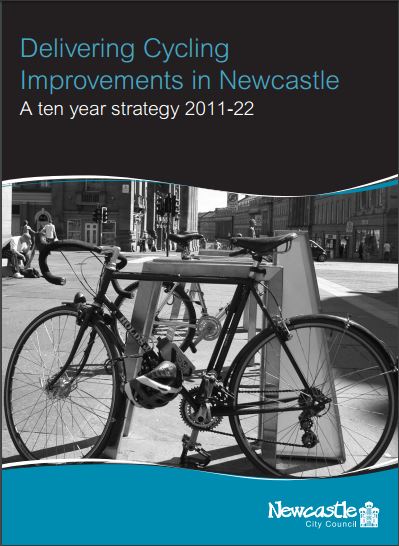 The overarching aim is to develop a cycling culture where 20% of all trips under five miles are undertaken by cycle by 2021. This will contribute towards making the city cleaner, more competitive and its people healthier. Cycling will also contribute to the economic growth of the city by cutting congestion and giving people more reliable journeys to work. It will also contribute to our aim of having a low carbon, energy resilient economy. Individuals who cycle will benefit from being healthier, less stressed, more productive at work and less likely to fall ill.
The overarching aim is to develop a cycling culture where 20% of all trips under five miles are undertaken by cycle by 2021. This will contribute towards making the city cleaner, more competitive and its people healthier. Cycling will also contribute to the economic growth of the city by cutting congestion and giving people more reliable journeys to work. It will also contribute to our aim of having a low carbon, energy resilient economy. Individuals who cycle will benefit from being healthier, less stressed, more productive at work and less likely to fall ill.
In addition, “Newcastle City Council seeks to have 80% of all trips under 5 miles undertaken by walking, cycling or public transport by 2022. As part of this target 20% of all trips under 5 miles will be undertaken by cycling by 2021 with an intermediate target of 10% by 2017″
The Council has developed 7 Strategic Cycle Routes (SCR) radiating from the city centre. SCR4 (in black) heads from the City Centre across Blue House through Gosforth High Street up to the Great Park. 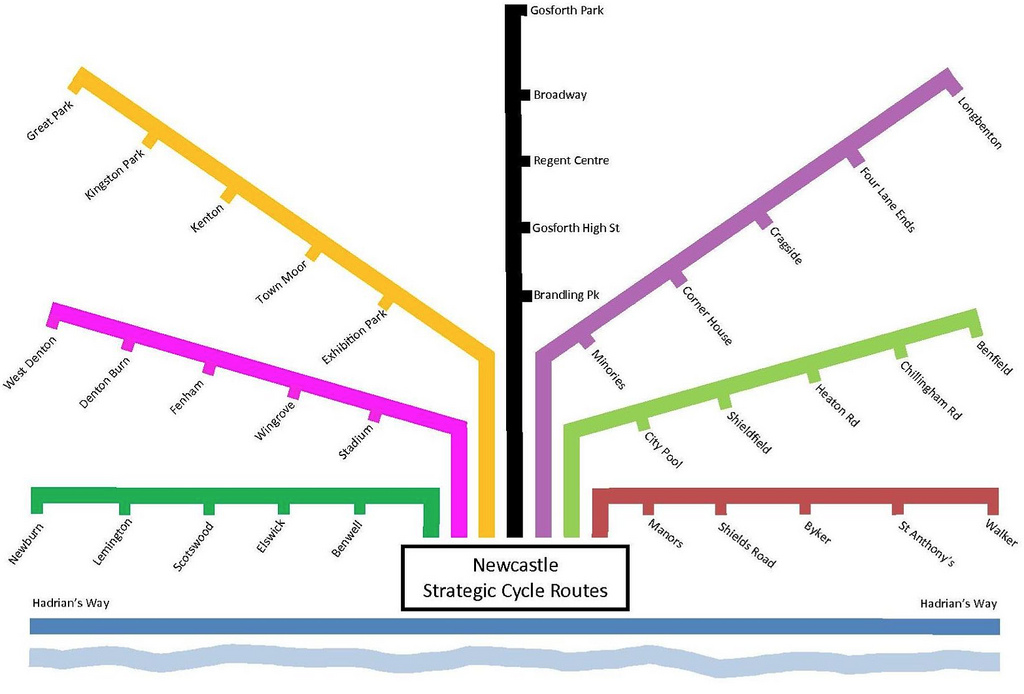
These policies are replicated at a national level, for example via The Cycling and Walking Investment Strategy, which sets out the ambition for “streets and public places which support walking and cycling and a road network where we will always consider improving infrastructure for cycling and walking when local and national routes are maintained, upgraded or built.”
2. Effect on safety
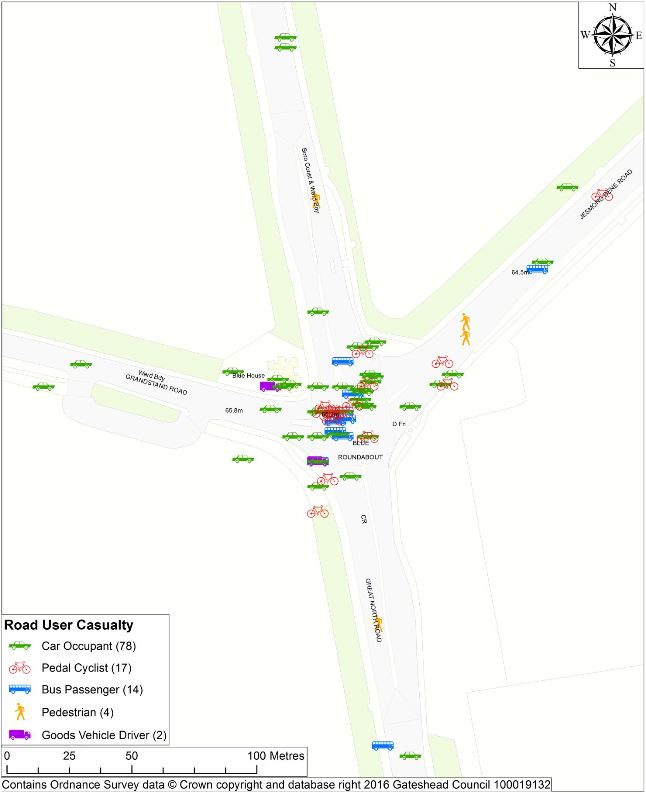 An Independent Traffic Accident and Data Unit Report has documented collision analysis on the junction between 2010 and June 2016 there have been 75 road traffic collisions involving an injury reported to Northumbria Police.
An Independent Traffic Accident and Data Unit Report has documented collision analysis on the junction between 2010 and June 2016 there have been 75 road traffic collisions involving an injury reported to Northumbria Police.
This number, while significant in its own right, understates the full impact of the current junction design as in addition to people injured as a result of road traffic collisions there will be a much greater number of collisions resulting in damage to vehicles and even more ‘near misses’ where collisions were narrowly avoided.
SPACE supports the Vision Zero concept which means no people should be killed or seriously injured as a result of traffic collisions, and would urge Newcastle City Council to join other cities around the UK in adopting the Vision Zero charter and target. To achieve this road junctions need to be designed not just to minimise the chances of a collision but just as importantly to minimise the impact when there is a collision. By eliminating danger and fear Vision Zero supports the objectives of increasing walking and cycling levels.
SPACE for Gosforth would like to propose that compliance with the principles of Vision Zero is the second success criteria for the Blue House and Jesmond Dene Road designs. In particular this should mean that an unaccompanied 11 year old should be able to use the junction safely on foot or by bike.
3. Impact on Air, Noise, and Light Pollution (added by SPACE)
This measure of success was not included in the original list of considerations proposed at the Working Group Meeting on 3/10/2016 but SPACE has included these three areas of pollution as they adversely impact on everyone.
Minimising all three pollution impacts is important not just for residents in the vicinity but for the quality of the environment experienced by everyone using the Town Moor.
3.1 Air Pollution
SPACE has covered the likely impact on public health as a result of increased traffic volumes in a previous article – Blue House – at what cost to health?
 Air Pollution, in the form of carbon dioxide emitted from vehicles, is also addressed in the City Wide Climate Change Strategy and Action Plan 2010-2020
Air Pollution, in the form of carbon dioxide emitted from vehicles, is also addressed in the City Wide Climate Change Strategy and Action Plan 2010-2020
By signing the EU ‘Covenant of Mayors’ agreement, we are committed to delivering a reduction in carbon emissions in excess of 20% by 2020
Road Transport contributes to 25% of our Carbon Footprint
Section 14 of the Action Plan focuses on Transport:
Promoting lower carbon choices falls into different categories of activity:
• Reducing the need to travel
• Providing lower carbon public transport
• Promoting the integration of transport modes
• Promoting other sustainable modes (walking, cycling)
• Promoting change through better information
• Reducing CO2 from business-related travel and the distribution of goods
Newcastle City Council created a Local Air Quality Action Plan for South Gosforth in 2011 due to the high levels of traffic-related air pollution in the area from Blue House north to Gosforth High Street and north east to Haddricks Mill. This zone follows the eastern, southern and western boundaries of East Gosforth Ward. Local authorities declare Air Quality Management Areas (“AQMAs”) when they believe they are unlikely to achieves their objectives in managing air pollution, and they also have to create a Local Air Quality Action Plan to improve air quality.
The map below shows the South Gosforth Air Quality Management Area.
As part of the action plan to bring air quality in Gosforth in line with national and EU legal limits, a package of measures has been proposed, alongside monitoring of the reductions in air pollution that they bring about. The Air Quality (England) Regulations 2000 (SI 928) and The Air Quality (England) (Amendment) Regulations 2002 (SI 3043) state that nitrogen dioxide (NO2) pollution should not exceed an annual average of 40μg/m3, and that the level of 200μg/m3 should not to be exceeded more than 18 times a year.
Monitoring undertaken in 2013 at Blue House roundabout showed that the annual mean concentration of NO2 pollution was 37.4μg/m3, which is below but very close to the legal limit. No monitoring, however, has been carried out at the junction for dangerous particulate or other pollution (see an earlier post by SPACE for Gosforth on this issue: https://www.spaceforgosforth.com/pollution-on-gosforth-high-street-first-results/ ).
SPACE for Gosforth propose that a measure of success for the new junctions is that they do not result in an increase in air pollution.
3.2 Noise Pollution
It is inevitable that larger junctions with increased volume of vehicles contribute adversely to noise pollution. Stand next to any road junction during rush hours and the ensuing noise is often deafening having an adverse impact on people and the environment. This impact can be significant as we set out in our post Billion Pound Issues on Gosforth High Street, “exposure to the sounds of car traffic significantly increases the risk of heart attack in people over 50. For every 10 decibels of increase in traffic noise, the risk of heart attacks rises 12 percent.”
Minimising Noise Pollution is intrinsically linked to minimising the volume of vehicles. The following image is taken from DEFRA’s Noise Mapping Service
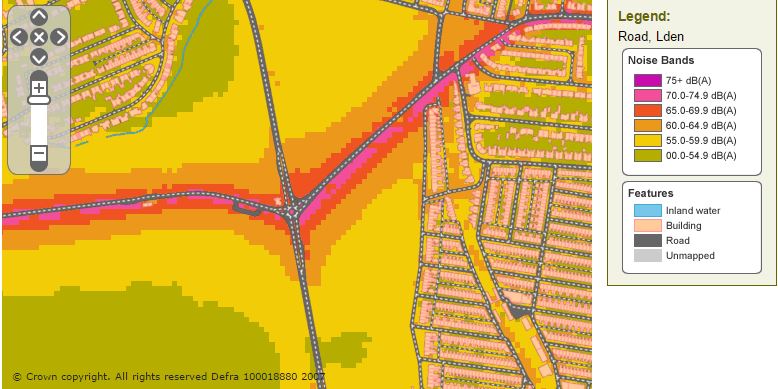
Defra Disclaimer: The maps shown in this site are only intended to be used for the strategic assessment of noise exposure in different areas. These maps should not be used to attempt to determine, represent or imply noise values at individual locations (e.g. individual houses).
As a proxy for reducing Noise and Air Pollution SPACE for Gosforth would like to propose a success criteria that the volume of vehicle traffic using Blue House continues to fall in line with the recent historical trends, which we highlighted in this post.
3.3 Light Pollution
SPACE for Gosforth has not found a specific Newcastle City Council policy covering Light Pollution (defined to be “excessive, misdirected or obtrusive artificial light”).
Note that this is different from directed street lighting which is an important part of ensuring people feel safe, especially when walking or cycling after dark.
It is reasonable to expect that light pollution from the junction does not increase and where possible should be decreased. The Campaign to Protect Rural England has produced recommendations for local government which include:
- all local authorities should have a policy to control light pollution in their Local Plan, in line with the NPPF and the associated National Planning Practice Guidance (NPPG) on light pollution. This should include identifying existing dark areas that need protecting
- all local authorities should consider preparing a Street Lighting Policy, which could include Environmental Lighting Zones to ensure that the appropriate lighting levels are used in each zone, with very strict requirements applying in identified dark areas
SPACE for Gosforth would like to propose a success criteria that the level of light pollution from the junction does not increase.
4. Visual Intrusion
 The Town Moor is a special area to everyone in Newcastle, see our article “Why is the Town Moor special?” , which examined the Environmental Impact Assessment Screening & Scoping Report (“the EIASSR”) for the proposed plan for Blue House.
The Town Moor is a special area to everyone in Newcastle, see our article “Why is the Town Moor special?” , which examined the Environmental Impact Assessment Screening & Scoping Report (“the EIASSR”) for the proposed plan for Blue House.
From the public feedback on the original proposed design, the two major dislikes of the design were Environmental concerns (74%) and Disportionate size (48%).
Visual intrusion is a theme that engineers can examine as part of a Landscape Character Assessment. SPACE could not find information on whether a Landscape Impact and Visual Impact Assessment (LVIA) was undertaken for the previous design (but we have asked).
Given the importance of the Town Moor to the City, SPACE would add to the success criteria that visual intrusion should be minimised and any future design be sympathetic to the unique position that Blue House is situated in.
To summarise, the success criteria SPACE for Gosforth would like to propose are:
- The Blue House and Jesmond Dene Road designs will:
- comply with Council policies set out in sections 11.6 and 11.12 of The Core Strategy and Urban Core Plan for Gateshead and Newcastle upon Tyne,
- support the development of a sustainable travel network as envisaged by the NECA 20 Year Transport Manifesto for the North East.
- support the achievement of targets set out in the Delivering Cycling Improvements in Newcastle strategy.
- The designs will be compliant with the principles of Vision Zero. This should mean that an unaccompanied 11 year old should be able to use the junction safely on foot or by bike.
- The volume of vehicle traffic using Blue House (and therefore noise and air pollution) continues to fall in line with recent historical trends.
- The level of light pollution from the junction does not increase.
- Visual intrusion is minimised and alternative designs must be sensitive and sympathetic to the Town Moor.
Our next blog post will continue addressing the Measures of Success criteria and will cover People Movement:
- Quality of provision for walking
- Quality of provision for cycling
- Quality of provision for buses
Please do let us know if you have any questions, comments or suggestions for how these measures could be improved to meet SPACE for Gosforth’s objective of a Safe Pedestrian and Cycling Environment for Gosforth.


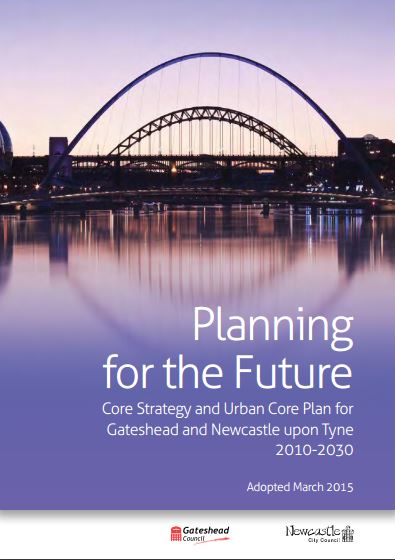
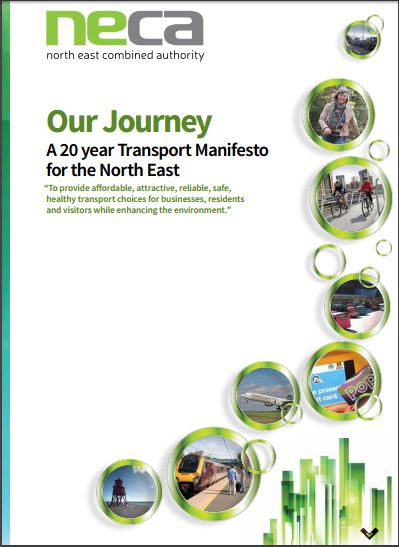
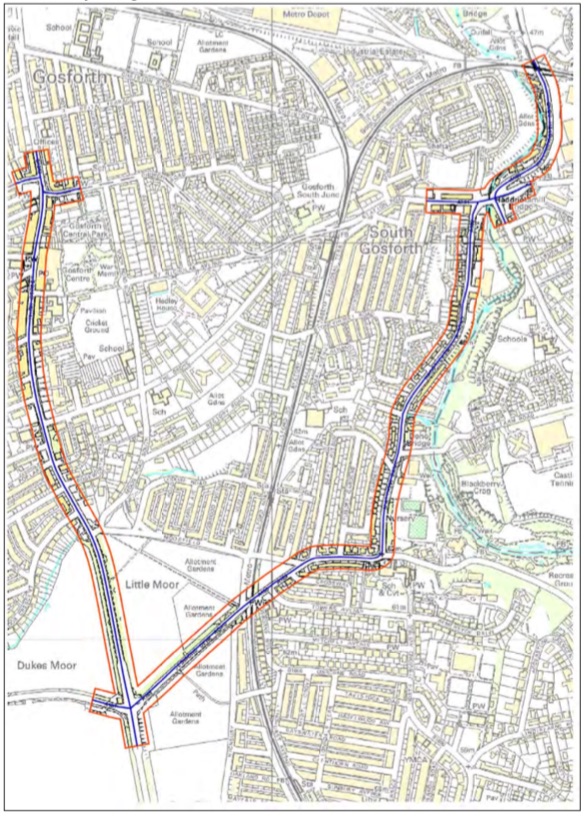
If the city is going to encourage cycling, I would suggest you train cyclists how to be proper road users, if indeed this is what they want to be. In my experience, they are road users AND pedestrians, depending on what their whim is, and can be thoughtless and dangerous on both the roads and pavements. They are terrifying.
Thanks for your comment Suzy. SPACE supports the implementation of safe separated infrastructure, which ensures that people who choose to cycle are not mixing with pedestrians and/or vehicles.
There are also many free training courses available: (e.g. https://www.bikeright.co.uk/newcastle/freewheeling/) but it’s not within our remit to actually train people.